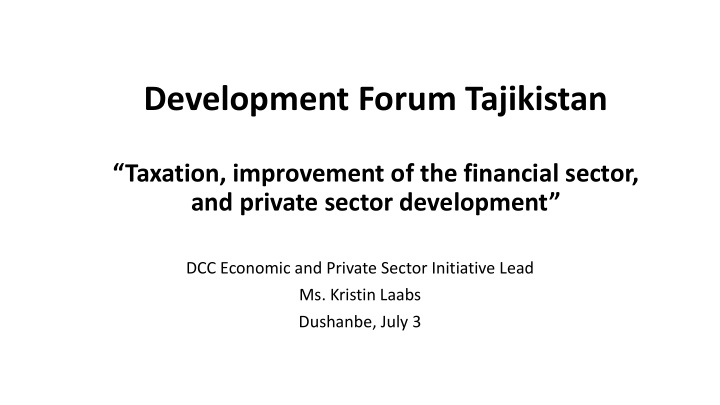



Development Forum Tajikistan “Taxation, improvement of the financial sector, and private sector development” DCC Economic and Private Sector Initiative Lead Ms. Kristin Laabs Dushanbe, July 3
FDI’s flow to Tajikistan (2007 -2017) • For the last 10 years the volume of foreign investments is almost on the same level ( US$990 mln-1100 mln ) • Since 2015 there is a reduction of total investments volume (exl Eurobonds): by 14% in 2016 , by 39% in 2017 • FDI(exl Eurobonds) : US$ 471mln in 2015 vs US$ 355 mln in 2017 • Other (under sovereign guarantee): US$ 507mln in 2015 vs US$ 246 mln in 2017
Private sector’s challenges
Formal economy vs shadow economy Formal economy Formal economy Pay taxes Shadow economy Shadow economy No taxes Government Government revenue revenue
Potential solutions MoJ, SCI, NBT, MoF, PPP Council, SCI, CCII, MoF Parliament, media MoETD SCI, MoETD Tax committee outlets, CSOs Rightsizing fiscal Creating business Strengthen Reduction of state and monetary friendly enforceability footprint environment policies Financial sector reform Tax reform Strengthening rule of law ongoing support from IMF, WB, ADB, EBRD, Ongoing support from WB, (economic courts etc) IFC, SECO Privatizing SOEs EU Ongoing support from DFID Issues to resolve : Financial Sector PPPs (in energy, Issues to resolve: Resilience : low level of capitalization, luck of healthcare, Main principles : 1. Tax administration issues resolution mechanisms, relatively high NPL, education, (simplification of rules and weak CG, large banks healthy practice, equal transport) regulations) 1. Enforcement of the rules without treatment of market players 2. Tax targets exemptions. 3.Tax incentives optimization 2. Simplification of rules and 4. PPD on tax issues on technical regulations. Public sector reform level and capacity building of the MoF on tax policies ongoing support of DFID, WB, ADB, USAID, 3. Right incentives for government UNDP, EFSD employees, Issues to resolve: 1. Strengthening public financial management Leveraging technologies 2. Improvement of public sector system (e-government) 3. Fiscal risks/Fiscal transparency Issues to resolve: 4. Low capacity to delivery services 1. Telecom sector challenges
Financial sector
Reforms 2015-2016 Focused to Tackle to Roots of Financial Crisis 2013 2.9% Unhealthy lending practices & Inadequate risk management STABILITY & INTEGRITY 2017 ACCESS & INCLUSION 20.1% Financial Stability and Unequal treatment of market players High NPLs Integrity SME access to finance erode capital by regulator to below the Banking regulation, minimum supervision, and crisis Distorted resource mobilization & allocations, Payment & Credit threshold management exacerbated by poor corporate governance, infrastructure reporting & provisioning practices Responsible financial Macro-financial Low levels of capitalization, particularly access monitoring within systemic banks $235 $21
Active Reforms in Financial Sector Brought Tangible Early Results Within 36 Month NPL ROA CAR 2017 20.1% 60% NPLs decreased 13% 54% 50% 50% CAR increased 4% 40% 37% 7.7% 2013 30% 23% ROA increased 1% 20% 19% 15% 10% 0.40% 0% -0.40% -2.80% $235 -10% Interministerial Financial Stability Committee is Approved June 2018
Potential solutions – Public Pri rivate Partnerships- game- changer for in infra and social service delivery ry • Challenges - No long-term vision on PPP; - Weak institutional capacity to generate development-relevant and fiscally- responsible PPPs; • Solutions: - Establishment of Project Development Facility (Pre/Feasibility studies and transaction advisory services) - Strengthening capacity of PPP Center and line ministries, and awareness campaign; - Build on success stories - Prioritization of PPP projects
Thank you!
More recommend